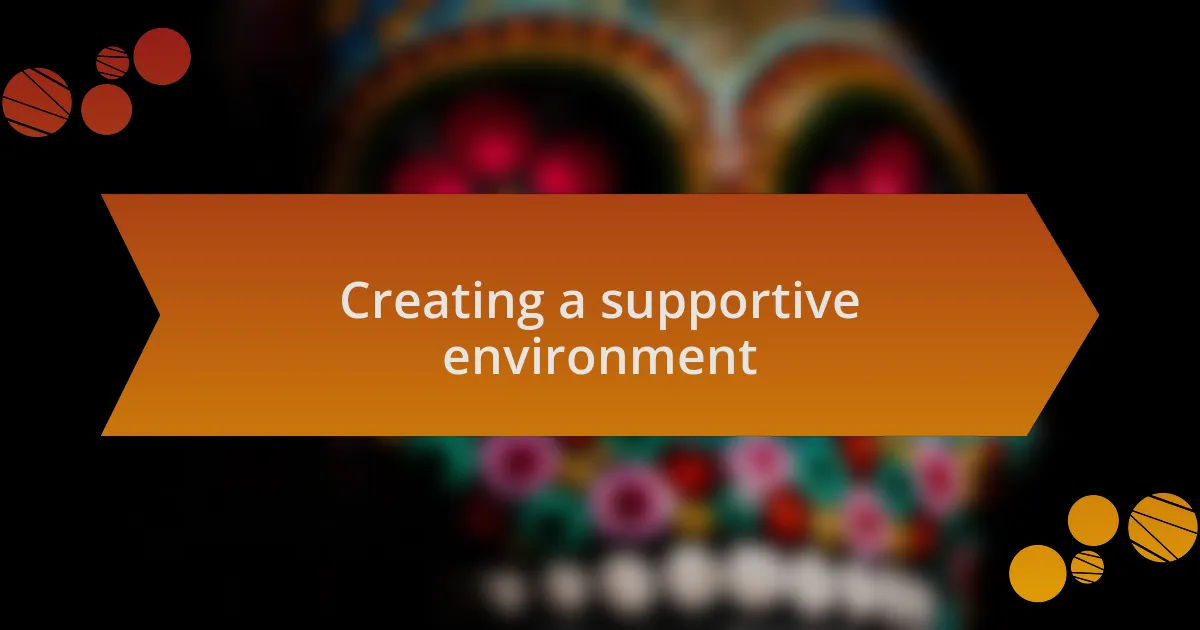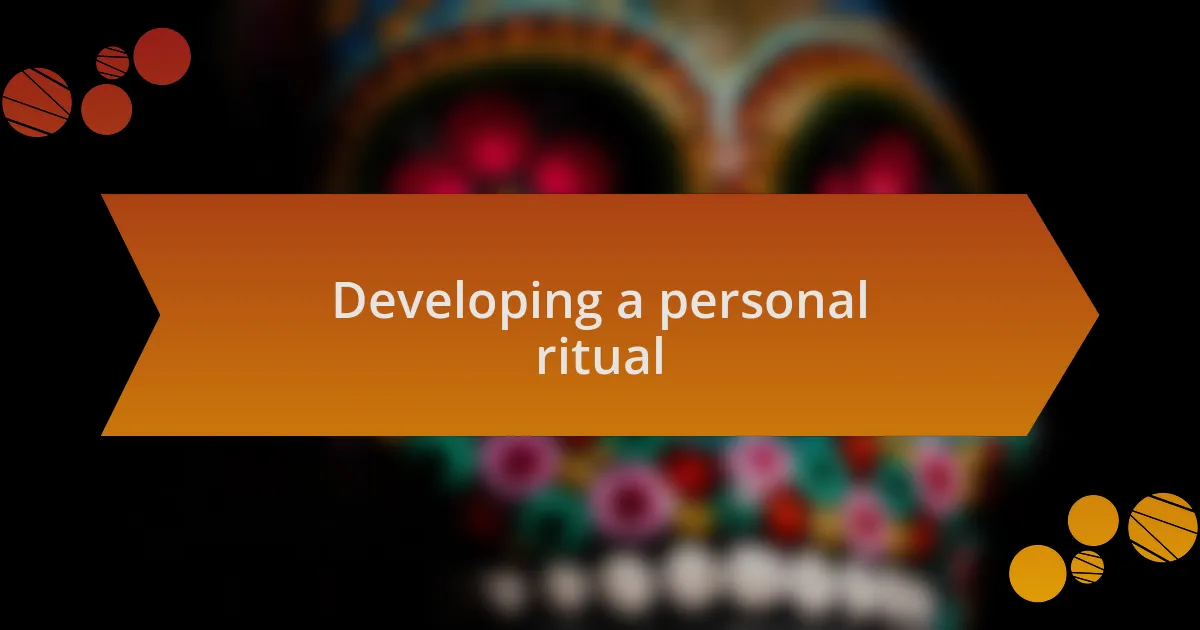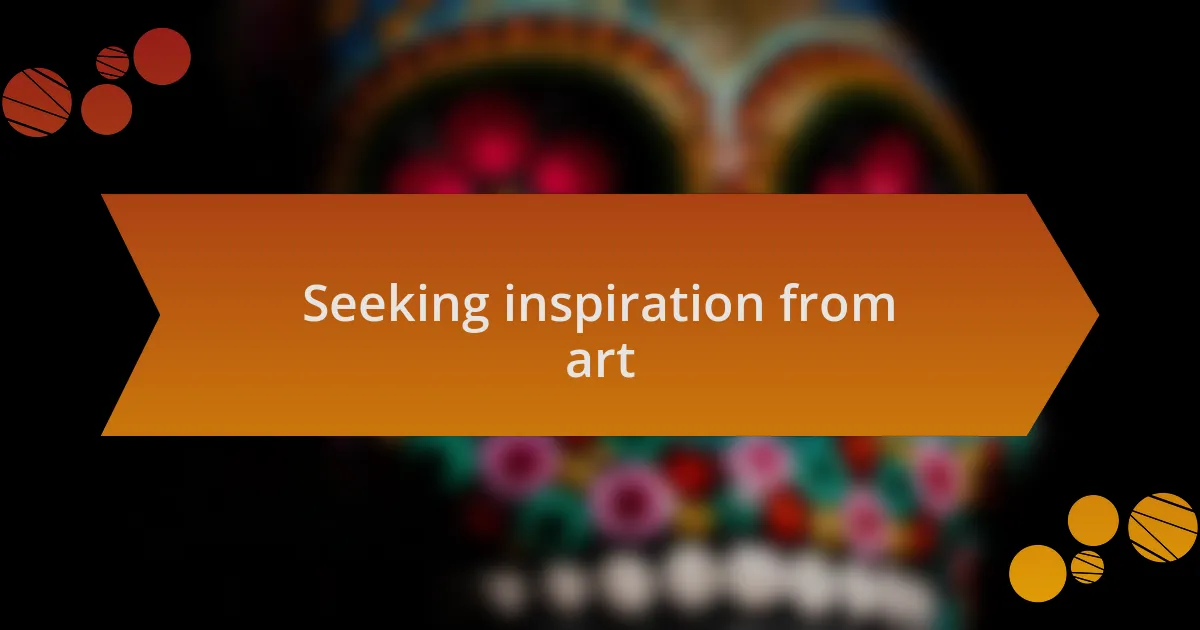Key takeaways:
- Artist’s block is a common experience that often stems from self-doubt, emotional turmoil, and external expectations.
- Techniques to overcome artist’s block include setting small goals, changing environments, and experimenting with new materials.
- Creating a supportive environment and sharing experiences with others can significantly enhance creativity and provide relief from creative blocks.
- Developing a personal ritual and seeking inspiration from artwork can help nurture creativity and reignite passion for art.
Understanding artist’s block
Artist’s block can feel like a heavy fog rolling into a clear day. I remember sitting in front of a blank canvas, feeling an overwhelming pressure to create something remarkable. It’s as if my mind was a locked door, and no amount of knocking could make it budge. Have you ever faced that daunting silence when ideas refuse to flow? It can be frustrating, and many artists experience it at some point in their journey.
Understanding artist’s block means recognizing it as a natural part of the creative process. I often find that it surfaces during times of self-doubt or when I’m trying to meet external expectations. That fear of not being good enough can stifle creativity. I wonder, how often do we allow outside opinions to dictate our artistic expression? Allowing myself to step back and breathe can be the key to regaining my creative spark.
What’s fascinating is that artist’s block often serves a purpose. It prompts reflection and invites a reassessment of my artistic direction. I recall a time when stepping away from my work led me to discover new techniques that reignited my passion. Could it be that the pauses in our creative lives hold hidden insights waiting to be uncovered? Embracing these moments can transform them from obstacles into valuable breaks that enrich our art.
Causes of artist’s block
Sometimes, the root of artist’s block lies in an overabundance of expectations—both our own and those we feel from others. I remember a particularly intense period when I was preparing for a gallery exhibition. The pressure to produce outstanding work felt like a weight on my chest, stifling my creativity. Have you ever felt like your art had to be “perfect”? This unrealistic standard can halt the creative process in its tracks.
Emotional turbulence can also trigger that frustrating block. I distinctly recall a time when I was dealing with upheaval in my personal life. My mind was consumed with thoughts that had nothing to do with my art. In those moments, I realized that my art often mirrors my emotions. Could it be that unresolved feelings create a barrier to expression? It’s crucial to acknowledge these feelings and understand that they can impede our creativity.
Another common cause of artist’s block is routine complacency. I found myself in a creative rut when I stuck to the same themes and techniques for too long. It felt comfortable, yet stifling. Have you ever noticed that often stepping outside your comfort zone can breathe new life into your art? That shift can be as simple as changing your medium or exploring a new subject. I learned the hard way that avoiding risk in creativity can lead to stagnation.
Techniques to overcome artist’s block
One of the techniques I often use to break through artist’s block is setting small, achievable goals. Instead of staring at a blank canvas with the pressure to create a masterpiece, I focus on completing a few quick sketches or studies. This shift in perspective allows me to create without the weight of expectation. Have you ever found that a simple, focused task can ignite a spark of inspiration that leads to something more?
Another approach that works wonders for me is changing my environment. A simple walk in a nearby park or visiting another art exhibit can provide fresh stimuli. I remember taking my sketchbook to a coffee shop, where the hustle and bustle sparked new ideas. It’s fascinating how a change of scenery can refresh our minds and encourage new perspectives on our work. Have you tried breaking away from your usual surroundings to influence your creativity?
I’ve also found that experimentation can be a powerful ally against artist’s block. When I feel stuck, I challenge myself to use unfamiliar materials or techniques. I once dabbled with digital art after years of traditional painting, and it felt like rediscovering my love for creating. Could it be that breaking free from our established norms allows for growth and renewal in our artistic journey? Embracing the unexpected can unlock a wealth of creativity.

Creating a supportive environment
Creating a supportive environment is essential for nurturing creativity. I find that surrounding myself with encouraging and like-minded individuals can make a significant difference. There was a time when I joined a local art group, and the energy and feedback from fellow artists transformed my practice. Have you experienced the impact of sharing your journey with others who understand your struggles?
Moreover, I believe that a physical space tailored to my creative needs fosters inspiration. I’ve intentionally decorated my studio with items that resonate with my artistic spirit—like images that evoke joy or textures that spark curiosity. This personalized environment acts as a gentle reminder of why I create, reducing that daunting sense of pressure. How do you set the stage for your creativity?
Finally, I’m a strong advocate for open communication about struggles like artist’s block. Sharing my experiences with friends or fellow creators not only alleviates feelings of isolation but often uncovers collective solutions. I recall venting my frustrations to a friend, only to discover she was grappling with similar challenges, and together, we brainstormed ways to tackle them. When was the last time you opened up about your creative hurdles?

Developing a personal ritual
Developing a personal ritual is like giving yourself a roadmap to navigate the often foggy terrain of creativity. For me, it starts with a consistent time and place dedicated to my art. Every morning, I set aside an hour just to sketch or paint, often with a warm cup of tea at my side. This routine has transformed my practice, making creativity feel like a natural extension of my day rather than a daunting task. Do you have a specific time when your creativity flows best?
In addition to time, I find that engaging all my senses enhances my creative ritual. For instance, I play soft music that resonates with my mood, creating an ambiance that helps me focus. One winter afternoon, I distinctly remember lighting a candle infused with sandalwood while I worked on a piece that had eluded me for weeks. The fragrance wrapped around me like a warm blanket, and suddenly, ideas began to flow. How do you stimulate your senses to invite inspiration into your art?
Lastly, I often incorporate a small, meditative moment before diving into my creative work. I take a few deep breaths, grounding myself in the present. I recall a particularly busy week when I felt overwhelmed; taking this time to center myself allowed me to approach my art without judgment or expectation. It’s a simple act that returns me to my passion rather than a sense of obligation. What rituals do you find helpful for clearing your mind before starting your creative journey?

Seeking inspiration from art
Art is a treasure trove of inspiration, and I often find myself wandering through galleries or browsing online exhibits when I’m feeling creatively blocked. Each piece tells a story that resonates with me in different ways, often sparking ideas I didn’t know I had. I remember standing captivated by a vibrant abstract painting that was full of emotion; it reminded me of a particular moment in my life and suddenly, I felt this surge of creativity that reignited my passion. How has a specific artwork inspired you in your own creative process?
At times, simply studying another artist’s technique can be like uncovering a hidden door to my own imagination. One afternoon, I spent hours watching a time-lapse video of a sculptor at work. The way they transformed raw materials into something beautiful left me in awe and prompted me to experiment with different mediums. It sparked a realization that inspiration isn’t just about the finished product but also about the journey of creation itself. Have you ever found a technique in someone else’s work that influenced your own?
I also believe that surrounding myself with art can catalyze inspiration. Whether it’s a piece proudly displayed in my studio or even a sketch taped to my wall, having these visual reminders serves as a constant source of motivation. I once rearranged my workspace to showcase my favorite pieces, and it was as if the walls themselves came alive with energy. That simple shift created an inviting environment that urged me to step back into my artistic flow. Where do you seek inspiration in your artistic surroundings?

Sharing experiences with others
Sharing experiences with others is a powerful tool in overcoming artist’s block. I remember attending a small group workshop where participants shared their struggles and triumphs. Hearing how others navigated through their creative droughts made me realize that I wasn’t alone in my feelings. Have you ever felt a sense of relief by simply knowing others face similar challenges?
In my own journey, discussing my creative process with fellow artists has been enlightening. I often find that a casual conversation can unveil new perspectives. For instance, after chatting with a friend about our artistic insecurities, I left feeling invigorated and eager to explore risks I had previously avoided. What if sharing your story could unlock new possibilities for your own artistic expression?
Sometimes, I take part in online forums to connect with artists from around the world. I vividly recall a heartwarming interaction with someone who had also struggled with a specific medium. Our exchange not only provided practical tips but led to deep discussions of our feelings surrounding art. At that moment, I realized that sharing experiences isn’t just about technique; it’s also about forming connections that can profoundly influence our creativity. How have shared stories ignited your own creative journey?